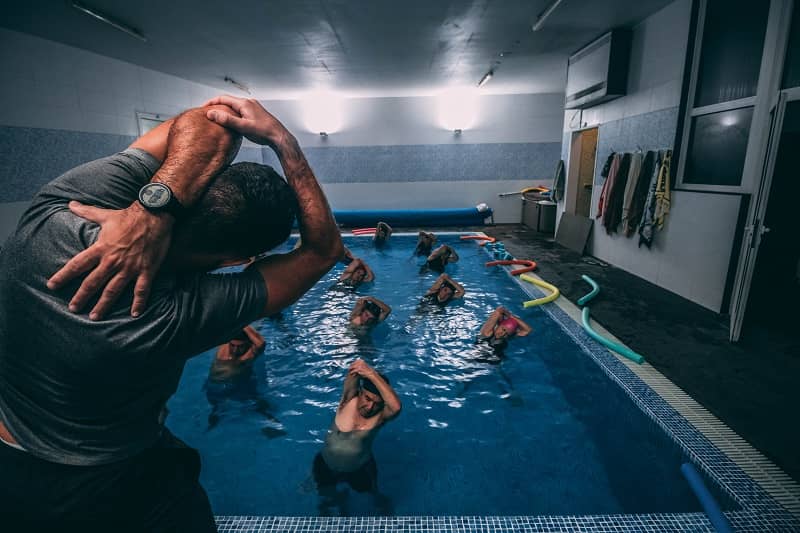Experiencing sudden weight loss? It could be the loss of muscle mass.
Well, winter is around the corner, and while this cozy weather has its own comfort, it also drags you to inactive mode leaving you with muscle pain.
And the muscle pain you’ve been ignoring lately thinking of it to be casual muscle soreness could be muscle atrophy.
Muscle atrophy or loss of muscles usually happens because of aging (sarcopenia) or a long period of inactivity (disuse).
Moreover, there are certain medical and other causes for muscle loss-more about it later.
Furthermore, while many people often overlook it or consider it as normal soreness, muscle atrophy could be a sign of something severe.
And ignoring it for longer can cause:
- Inability to walk and balance
- Muscle numbness
- Difficulty in sleeping and swallowing
- Visible weakness
- Depression and other mental disorders.
Nevertheless, it can be cured in many conditions.
Hence, without wasting much time, let’s find out what causes loss of muscle mass, its signs and symptoms, and ways to stop it.
What Causes Loss Of Muscle Mass?

Muscle Atrophy or decrease in muscle mass is a normal condition and can be a sign of chronic health and mental issues.
The causes of disuse atrophy (loss of muscle mass due to lack of movement) could be anything from a sedentary lifestyle to being bedridden to rheumatoid arthritis.
Moreover, what causes muscle loss could be even anything as simple as aging as well.
And if lost at a rapid rate, muscle atrophy could be dangerous.
Hence, it becomes important to know the causes of loss of muscle mass.
Some of the causes of loss of muscle are:
#1. General Causes
General causes of muscle loss include:
- Aging
- Lack of exercise
- Sedentary lifestyle
- Inflammation of your stomach or intestines
- Malabsorption due to gastrointestinal diseases.
#2. Psychiatric Diseases
Some of the psychiatric diseases that contribute to muscle atrophy are:
- Mood disorders like depression can cause a lack of appetite.
- Reduction in nutritional intake due to eating disorders.
- Substance abuse or drug overuse also leads to weight loss and muscle loss.
#3. Medical Causes
Medical causes leading to loss of muscle mass and strength are as follows:
- Characterized with body fat and overall weight loss, cancer wasting or cancer cachexia is one of the reasons for muscle atrophy.
- Chronic lungs, kidney, and heart diseases.
- Some medical treatments can also cause loss of muscle mass.
- Endocrine diseases like diabetes and thyroid.
- Infectious diseases can cause weight loss due to the breakdown of tissues to generate energy.
- Muscle loss in legs and buttocks can also be because of polio.
#4. Neurological Causes
The decline in muscle mass could also be because of neurological issues.
Some of the neurological causes behind muscle loss or muscle atrophy are:
- Nerve damage due to high blood sugar levels.
- Amyotrophic lateral sclerosis (a severe neuromuscular disease that causes muscle loss)
- Injury in the neck and spinal cord
- Spinal cord atrophy (genetic disorder due to neural defect)
In some cases, muscle loss could also be because of malnutrition and alcohol-related disease as well.
Although the sudden loss of muscle mass could be alarming, many people seem to ignore it at its early stage.
Nevertheless, over time, there could be visible and life-threatening changes in the body.
Hence, this makes it essential to know the signs and symptoms of loss of muscle mass.
What Are The Signs Of Muscle Atrophy?

Signs of muscle atrophy in hands, legs, and overall body could be varied and depends upon underlying medical conditions, disorders, and diseases.
Moreover, apart from muscle loss, symptoms of muscle atrophy include:
#1. Malnutrition-Related Muscle Atrophy Symptoms
Some of the symptoms of malnutrition-related muscle atrophy include:
- Loss of appetite
- Dizziness on standing up
- Low level of blood proteins and iron level
The main factors responsible for these symptoms are a decrease in food intake and a decline in nutrient absorption due to certain diseases.
#2. Disuse Muscle Atrophy Symptoms
Some of the symptoms of muscle atrophy include:
- Visible weight loss
- Loss of muscle strength
- Low physical activity due to aging
- Sitting jobs and sedentary lifestyle
The reason behind low physical activity could be a chronic disease, severe burn leading to bedridden conditions.
#3. Neurological Muscle Atrophy Symptoms
Some of the symptoms of muscle atrophy include:
- Uncontrolled twitching
- Muscle cramping
- Decreased muscle strength
- Changes in skin, hair, and nails
The symptoms of neurological muscle atrophy could be anything from nerve injuries to neurological diseases like Guillain-Barré syndrome
If in any case you are dealing with any of these symptoms, you must not ignore them and look for treatments to cure them.
So, what does it mean? Can muscle atrophy be reversed?
Of course, yes!
However, just like signs, treatments of muscle loss also vary depending upon the severity and what causes you to lose muscle mass.
Having said that, let’s know how can you treat muscle atrophy.
How To Stop Losing Muscle Mass?
Just like how bone density and hormones decrease after a certain age, loss of muscle mass also happens because of increasing age.
And although there are innumerable other reasons, thankfully it can be treated if early measures are taken.
Some of the ways to treat muscle atrophy and loss of muscle mass are:
#1. At-Home Treatments
#2. Physical Therapies
#3. Medical Treatments
#4. Muscle Atrophy Exercises
Let’s see in detail how can you slow down the progress of muscle loss with the above-mentioned ways.
#1. At-Home Treatments
If your muscle loss is at an early stage, you can try the following home treatments to address the symptoms.
1. Eat Well
Avoid eating junk food and add nutrient-rich foods to your meals. Notably, not having nutritious food could be one of the primary reasons behind muscle loss.
Eat enough protein, carbohydrates, and food with omega-3 fatty acids.
Adding to this, eating disorders because of mental illness can also be the reason for your bad eating habits.
Hence, if by any chance you have a food eating disorder, meet the nutritionist.
If your body doesn’t get enough nutrients, it will end up breaking muscles for generating energy.
Hence, first thing is to eat well to recover from muscle loss.
2. Sleep Enough
Don’t underestimate the power of sleep time. It helps in rebuilding and repairing.
Since emotional stress stimulates catabolic stress hormones, the destruction of muscles can take place.
Hence, make sure to get enough sleep and relax well!
3. Limited Alcohol Intake
“Alcohol consumption is injurious to health.”
Well, it’s not mere a quote.
Drinking excess alcohol will do no good to your muscle mass.
That is to say, apart from all the other side effects of drinking alcohol, excess alcohol consumption can cause a rise in estrogen levels and a decline in testosterone levels.
This imbalance in hormones can degrade your muscles.
#2. Physical Therapies

Many times, performing physical therapies can aid in muscle atrophy.
The fact that muscle loss can occur due to long inactivity, performing stretches and exercises can benefit those suffering from muscle atrophy.
Physical therapy can:
- Improve blood circulation
- Improves muscle strength
- Increases mobility
- Reduces spasticity due to continuous muscle contraction.
#3. Medical Treatments
If at-home treatments and physical therapies are not working, it’s time you should see the doctor.
To elaborate, once you encounter the symptoms of muscle atrophy or muscle loss, you can try eating well and therapies.
But in case you’re not being benefited or if the cause of muscle atrophy is any injury or underlying medical conditions, it’s better to consult a physician.
Some of the medical treatments available are:
- Focused Ultrasound Therapy
As the name suggests, focused ultrasound therapy delivers ultrasound beams to specific body areas.
It revitalizes the contraction of atrophied muscles.
- Surgery
This is the last resort.
If nothing works, surgery could be the last option for many.
Muscle atrophy because of neurological conditions, malnutrition, and severe injuries can be cured.
Surgical procedures improve muscle mobility and improve function.
#4. Muscle Atrophy Exercises
You can do a lot on your own to treat muscle atrophy and increase muscle gain.
And while making dietary improvements is what many people try first, adopting muscle atrophy exercises in your workout regime can also help you regain what you have lost.
Some of the exercises that can help you aid muscle atrophy are:
- Strength Training
- Cardio workouts
- Flexibility Exercises
Once you know what causes loss of muscle mass and strength, you can undoubtedly use exercises to build atrophied muscles.
However, before that, it’s recommended to consult your personal trainer and nutritionist to ensure you are on right track.
Having said that, let’s have a closer look at some of the exercises to reverse muscle atrophy’s effect.
At-Home Muscle Atrophy Exercises
Although the loss of muscle mass and strength can be reversed, it might take some time.
And to improve the process, one can add physical exercises along with good nutrition and medicinal treatment.
It is one of the natural and most effective methods to reverse muscle atrophy. And once you feel ready to be active again, illness and weakness can create a hurdle.
Therefore, before I tell you about the exercises, it’s important to note that you should start slowly and under the guidance of a personal trainer.
Moving on, some of the exercises to improve muscle loss are:
#1. Water Exercises

Water exercises like swimming and other underwater exercises can help improve the dull muscle, repair muscle recovery, treat muscle soreness, and tone atrophied muscles.
You can do:
- Complete water push-ups
- Walk around the pool
- Try knee lift in the pool
While water exercises are best done with a trainer, you can start with these easy exercises.
#2. Body Weight Exercises
If you feel comfortable doing water exercises, you can move on to bodyweight exercises.
Using your bodyweight to exercise can help you do more repetitions.
You can target specific muscle groups and choose the exercises accordingly to increase their effectiveness.
#3. Cardio Exercises
Adding some cardio exercises in your workout regime will not only help you prevent loss of muscle mass in legs but also help build back the lost muscles.
To start with, you can do 10-15 minutes of walking every day.
And gradually you can increase the speed and time to 30 minutes.
#4. Regular Stretching
Make sure you don’t forget to stretch regularly before and after the workout.
Stretching exercises warm up your muscles and increase the range of motion.
Make sure to prepare a separate session of stretching for 15-30 minutes in which you target all your major muscles.
You can start with back stretching and move accordingly to neck, shoulder, lower back, and leg stretching.
Keep your expectations realistic and stay motivated while you work towards achieving your body goals.
“What you think is what you become.”
So, if you are not thinking right, you won’t be able to conquer it.
Before You Go!
Many people dealing with muscle atrophy don’t really know what can cause muscle loss in the first place; let alone the ways to recover from it.
And this is the reason they feel de-motivated.
Because of its varied causes, muscle atrophy can happen to anyone. Nevertheless, one must know that they can recover from it if tackled at its early stage.
One can easily combat muscle atrophy with a proper nutritious diet, muscle atrophy exercises, and medical treatments.
You can simply get muscle atrophy with aging as well.
So, keep yourself active to prevent it in the first place.
FAQs
Right below are the answers to the most recently asked questions.
#1. Is losing muscle bad?
Losing muscle mass is often healthier and is generally linked with aging.
However, a sudden and unnatural decline in muscle mass can be worrisome.
#2. Does walking cause muscle loss?
No, general walking will not lead to muscle loss.
However, if you are walking to lose muscle and reduce weight, it needs to be more intense than mere walking.
#3. How do you know if you have lost fat or muscle?
If the numbers in your weigh scale are decreasing but the pinchable fat is the same, then you’ve lost muscle not fat.
#4. How long does it take to build noticeable muscle?
Muscle gaining results are not always fat. It takes around 3-4 weeks to see visible changes.
Moreover, it also depends upon the causes behind your muscle loss and the ways to recover the lost muscles as well.
#5. Can a pinched nerve cause muscle wasting?
Applying too much pressure on a particular nerve can damage or disrupt the nerve’s function and can cause muscle wasting.
#6. How long does it take to lose muscle?
It often takes around 3-5 weeks of inactivity to lose muscle mass.
Be active, eat well, and if needed, consult the doctor to keep yourself safe from muscle atrophy.
Hope you liked this informative blog. Let us know if we missed anything and don’t shy away to share your views in the comments section below.